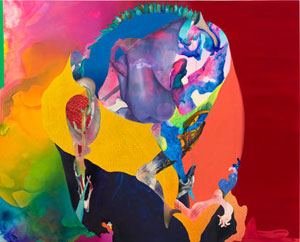9.13.24 — After the Glow
Ask an artist about what went into a work, and you may hear quite a story about myths and memories. You will have your own stories at that—of what you have experienced, seen in the art you love, heard from your parents, and read. And curators attuned to matters of gender and culture eat it up.
Ask again, though, about what the artist had in mind, and you may hear something far more modest. I just want to make art, some might say, to see its color and the light. The seven artists in “Overflow, Afterglow” get to have it both ways, the stories and the light, and the Jewish Museum wants it all. It sees, as the show’s subtitle has it, “Chromatic Figuration,”  through September 15, and it sees a trend. With two artists in their mid-twenties and just one much past forty, it hopes to lead the way to the future. But will the afterglow fade all too quickly, and is the overflow a bit much?
through September 15, and it sees a trend. With two artists in their mid-twenties and just one much past forty, it hopes to lead the way to the future. But will the afterglow fade all too quickly, and is the overflow a bit much?
Chromatic figuration may sound more like color charts and color wheels than an afterglow. It may not, in fact, sound much like figuration. Yet the wall between abstraction and representation has been crumbling for years now, as geometry has given way to excess. With “Overflow, Afterglow,” regular shapes are nowhere in sight, but everything else is, and the break with Minimalism’s white cube begins with the installation. Each artist gets a bay of angled walls, each at a different angle and painted a different color. Together, they fill a single room, with sightlines from one to next.
Figuration, too, can be elusive, although Rosha Yaghmai insists that sheer color is figurative. Portraits by Sasha Gordon look conventional enough, but notably short of joy or affection. Others may tell stories, but the stories are hard to hear. Sara Issakharian includes hands, snakes, charioteers, and an eastern goddess in mortal combat, but who knows who is winning this war? Austin Martin White throws in a “hypothetical” African sculpture, but his heart is in chaos. Sula Bermúdez-Silverman promises a take on colonialism, but it never extends beyond work with actual rubber and sugar.
Color itself enters in different ways. It comes brushed on wildly, layered on beeswax, and squeezed through a nylon mesh. It can have what the museum calls “supernatural color” or the paleness of skin tones. It comes shining from resin and uranium glass. It all but bleeds out of a silicon trans figure by Chella Man, with the scars of multiple operations in its crotch. It lies nude on its back, ready for more.
The artists do share strategies. Ilana Savdie imagines narratives of hunters and their prey, while Gordon’s women train their rifles on a bird, the only thing separating or connecting them. Issakharian has her scenes of combat and celebration, White his Bacchanalia. Rosha Yaghmai paints on cotton and organza, creating moiré patterns, much like White’s nylon mesh. These are Yaghmai’s “afterimages,” and they appear and vanish before one’s eyes. The curators, Liz Munsell and Leon Levy, see “uncanny luminescence” everywhere, and at last they get it.
Not all the artists are Jewish, and those that are come with hyphens, like Issakharian, an Iranian Jewish immigrant, and Man, Jewish Chinese. For Bermúdez-Silverman, a hyphenated name and her dollhouse alike speak of home. They suit a time of pride in shifting identities. They are also new to New York museums (although one has showed with an upscale dealer and museum veteran, Jeffrey Deitch), but are they the future? They occupy the same exhibition space as “New York: 1962–1964” in 2022, which looked back to a time when the Jewish Museum introduced an entire generation, from Pop Art to formalism. Can it happen again?
The artists, the museum argues, “take on and take in the oversaturation of our contemporary moment,” but do they merely succumb to it? When “color is flexible and amorphous,” can it stand for anything at all? To think back to 1962, more than one critic looked at the dizzying designs of Bridget Riley and saw a movement. It must have seemed the next big thing, where in retrospect it was the field of play for little more than a singular talent. Could “chromatic figuration,” with all its failed narratives and optical activity, be the Op Art of today? It could be just as passing and a lot tackier.
Read more, now in a feature-length article on this site.